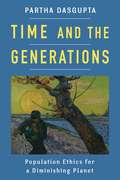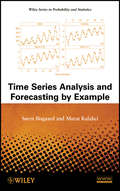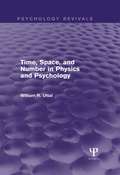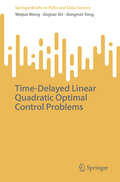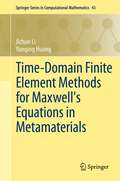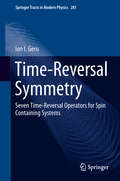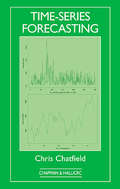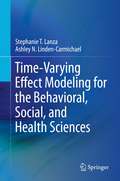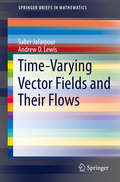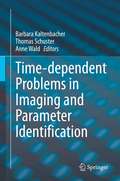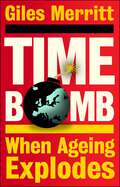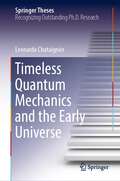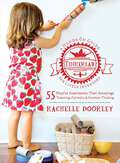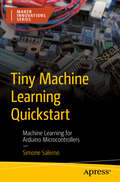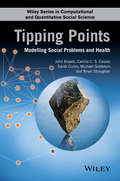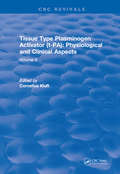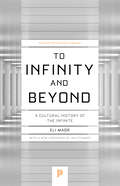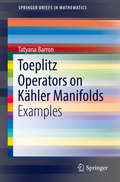- Table View
- List View
Time and the Generations: Population Ethics for a Diminishing Planet (Kenneth J. Arrow Lecture Series)
by Partha DasguptaHow should we evaluate the ethics of procreation, especially the environmental consequences of reproductive decisions on future generations, in a resource-constrained world? While demographers, moral philosophers, and environmental scientists have separately discussed the implications of population size for sustainability, no one has attempted to synthesize the concerns and values of these approaches. The culmination of a half century of engagement with population ethics, Partha Dasgupta’s masterful Time and the Generations blends economics, philosophy, and ecology to offer an original lens on the difficult topic of optimum global population.After offering careful attention to global inequality and the imbalance of power between men and women, Dasgupta provides tentative answers to two fundamental questions: What level of economic activity can our planet support over the long run, and what does the answer say about optimum population numbers? He develops a population ethics that can be used to evaluate our choices and guide our sense of a sustainable global population and living standards. Structured around a central essay from Dasgupta, the book also features a foreword from Robert Solow; correspondence with Kenneth Arrow; incisive commentaries from Joseph Stiglitz, Eric Maskin, and Scott Barrett; an extended response by the author to them; and a joint paper with Aisha Dasgupta on inequalities in reproductive decisions and the idea of reproductive rights. Taken together, Time and the Generations represents a fascinating dialogue between world-renowned economists on a central issue of our time.
Time series analysis and forecasting by example
by Soren Bisgaard Murat KulahciAn intuition-based approach enables you to master time series analysis with ease Time Series Analysis and Forecasting by Example provides the fundamental techniques in time series analysis using various examples. By introducing necessary theory through examples that showcase the discussed topics, the authors successfully help readers develop an intuitive understanding of seemingly complicated time series models and their implications. The book presents methodologies for time series analysis in a simplified, example-based approach. Using graphics, the authors discuss each presented example in detail and explain the relevant theory while also focusing on the interpretation of results in data analysis. Following a discussion of why autocorrelation is often observed when data is collected in time, subsequent chapters explore related topics, including: Graphical tools in time series analysis Procedures for developing stationary, non-stationary, and seasonal models How to choose the best time series model Constant term and cancellation of terms in ARIMA models Forecasting using transfer function-noise models The final chapter is dedicated to key topics such as spurious relationships, autocorrelation in regression, and multiple time series. Throughout the book, real-world examples illustrate step-by-step procedures and instructions using statistical software packages such as SAS®, JMP, Minitab, SCA, and R. A related Web site features PowerPoint slides to accompany each chapter as well as the book's data sets. With its extensive use of graphics and examples to explain key concepts, Time Series Analysis and Forecasting by Example is an excellent book for courses on time series analysis at the upper-undergraduate and graduate levels. it also serves as a valuable resource for practitioners and researchers who carry out data and time series analysis in the fields of engineering, business, and economics.
Time, Space, and Number in Physics and Psychology (Psychology Revivals)
by William R. UttalThe crux of the debate between proponents of behavioral psychology and cognitive psychology focuses on the issue of accessibility. Cognitivists believe that mental mechanisms and processes are accessible, and that their inner workings can be inferred from experimental observations of behavior. Behaviorists, on the contrary, believe that mental processes and mechanisms are inaccessible, and that nothing important about them can be inferred from even the most cleverly designed empirical studies. One argument that is repeatedly raised by cognitivists is that even though mental processes are not directly accessible, this should not be a barrier to unravelling the nature of the inner mental processes and mechanisms. Inference works for other sciences, such as physics, so why not psychology? If physics can work so successfully with their kind of inaccessibility to make enormous theoretical progress, then why not psychology? As with most previous psychological debates, there is no "killer argument" that can provide an unambiguous resolution. In its absence, author William Uttal explores the differing properties of physical and psychological time, space, and mathematics before coming to the conclusion that there are major discrepancies between the properties of the respective subject matters that make the analogy of comparable inaccessibilities a false one. This title was first published in 2008.
Time-Delayed Linear Quadratic Optimal Control Problems (SpringerBriefs on PDEs and Data Science)
by Jiongmin Yong Weijun Meng Jingtao ShiThis book characterizes the open-loop and closed-loop solvability for time-delayed linear quadratic optimal control problems. Different from the existing literature, in the current book, we present a theory of deterministic LQ problems with delays which has several new features: Our system is time-varying, with both the state equation and cost functional being allowed to include discrete and distributed delays, both in the state and the control. We take different approaches to discuss the unboundedness of the control operator. The open-loop solvability of the lifted problem is characterized by the solvability of a system of forward-backward integral evolution equations and the convexity condition of the cost functional. Surprisingly, the adjoint equations involve some coupled partial differential equations, which is significantly different from that in the literature, where, the adjoint equations are all some anticipated backward ordinary differential equations. The closed-loop solvability is characterized by the solvability of three equivalent integral operator-valued Riccati equations and two equivalent backward integral evolution equations which are much easier to handle than the differential operator-valued Riccati equations used in the literature to study similar problems. The closed-loop representation of open-loop optimal control is presented through three equivalent integral operator-valued Riccati equations.
Time-Dependent Problems and Difference Methods
by Joseph Oliger Bertil Gustafsson Heinz-Otto KreissPraise for the First Edition". . . fills a considerable gap in the numerical analysis literature by providing a self-contained treatment . . . this is an important work written in a clear style . . . warmly recommended to any graduate student or researcher in the field of the numerical solution of partial differential equations."--SIAM ReviewTime-Dependent Problems and Difference Methods, Second Edition continues to provide guidance for the analysis of difference methods for computing approximate solutions to partial differential equations for time-dependent problems. The book treats differential equations and difference methods with a parallel development, thus achieving a more useful analysis of numerical methods.The Second Edition presents hyperbolic equations in great detail as well as new coverage on second-order systems of wave equations including acoustic waves, elastic waves, and Einstein equations. Compared to first-order hyperbolic systems, initial-boundary value problems for such systems contain new properties that must be taken into account when analyzing stability. Featuring the latest material in partial differential equations with new theorems, examples, and illustrations,Time-Dependent Problems and Difference Methods, Second Edition also includes:High order methods on staggered gridsExtended treatment of Summation By Parts operators and their application to second-order derivativesSimplified presentation of certain parts and proofsTime-Dependent Problems and Difference Methods, Second Edition is an ideal reference for physical scientists, engineers, numerical analysts, and mathematical modelers who use numerical experiments to test designs and to predict and investigate physical phenomena. The book is also excellent for graduate-level courses in applied mathematics and scientific computations.
Time-Domain Finite Element Methods for Maxwell's Equations in Metamaterials
by Jichun Li Yunqing HuangThe purpose of this book is to provide an up-to-date introduction to the time-domain finite element methods for Maxwell's equations involving metamaterials. Since the first successful construction of a metamaterial with both negative permittivity and permeability in 2000, the study of metamaterials has attracted significant attention from researchers across many disciplines. Thanks to enormous efforts on the part of engineers and physicists, metamaterials present great potential applications in antenna and radar design, sub-wavelength imaging, and invisibility cloak design. Hence the efficient simulation of electromagnetic phenomena in metamaterials has become a very important issue and is the subject of this book, in which various metamaterial modeling equations are introduced and justified mathematically. The development and practical implementation of edge finite element methods for metamaterial Maxwell's equations are the main focus of the book. The book finishes with some interesting simulations such as backward wave propagation and time-domain cloaking with metamaterials.
Time-Fractional Differential Equations: A Theoretical Introduction (SpringerBriefs in Mathematics)
by Masahiro Yamamoto Adam Kubica Katarzyna RyszewskaThis book aims to establish a foundation for fractional derivatives and fractional differential equations. The theory of fractional derivatives enables considering any positive order of differentiation. The history of research in this field is very long, with its origins dating back to Leibniz. Since then, many great mathematicians, such as Abel, have made contributions that cover not only theoretical aspects but also physical applications of fractional calculus. The fractional partial differential equations govern phenomena depending both on spatial and time variables and require more subtle treatments. Moreover, fractional partial differential equations are highly demanded model equations for solving real-world problems such as the anomalous diffusion in heterogeneous media. The studies of fractional partial differential equations have continued to expand explosively. However we observe that available mathematical theory for fractional partial differential equations is not still complete. In particular, operator-theoretical approaches are indispensable for some generalized categories of solutions such as weak solutions, but feasible operator-theoretic foundations for wide applications are not available in monographs.To make this monograph more readable, we are restricting it to a few fundamental types of time-fractional partial differential equations, forgoing many other important and exciting topics such as stability for nonlinear problems. However, we believe that this book works well as an introduction to mathematical research in such vast fields.
Time-Reversal Symmetry: Seven Time-Reversal Operators for Spin Containing Systems (Springer Tracts in Modern Physics #281)
by Ion I. GeruThis book introduces new developments in the field of Time-Reversal Symmetry presenting, for the first time, the Wigner time-reversal operator in the form of a product of two- or three time-reversal operators of lower symmetry. The action of these operators leads to the sign change of only one or two angular momentum components, not of all of them. It demonstrates that there are six modes of time-reversal symmetry breaking that do not lead to the complete disappearance of the symmetry but to its lowering. The full restoration of the time-reversal symmetry in the six cases mentioned is possible by introducing six types of metaparticles. The book also confirms the presence of six additional time-reversal operators using a group-theoretical method. The problem is only where to seek these metaparticles. The book discusses time-reversal symmetry in classical mechanics, classical and relativistic electrodynamics, quantum mechanics and theory of quantized fields, including dynamical reversibility and statistical irreversibility of the time, Wigner’s and Herring’s criteria, Kramers theorem, selection rules due to time-reversal symmetry, Onsager’s relations, Poincaré recurrence theorem, and CPT theorem. It particularly focuses attention on time-reversal symmetry violation. It is proposed a new method of testing the time-reversal symmetry, which is confirmed experimentally by EPR spectroscopy data. It shows that the traditional black-white point groups of magnetic symmetry are not applicable to magnetic systems with Kramers degeneration of energy levels and that magnetic groups of four-color symmetry are adequate for them. Further, it addresses the predicted structural distortions in Kramers three-homonuclear magnetic clusters due to time-reversal symmetry that have been identified experimentally. Lastly, it proposes a method of synthesis of two-nuclear coordination compounds with predictable magnetic properties, based on the application of the time-reversal transformation that was confirmed experimentally.
Time-Series Forecasting
by Chris ChatfieldFrom the author of the bestselling "Analysis of Time Series," Time-Series Forecasting offers a comprehensive, up-to-date review of forecasting methods. It provides a summary of time-series modelling procedures, followed by a brief catalogue of many different time-series forecasting methods, ranging from ad-hoc methods through ARIMA and state-space
Time-Varying Effect Modeling for the Behavioral, Social, and Health Sciences
by Stephanie T. Lanza Ashley N. Linden-CarmichaelThis book is the first to introduce applied behavioral, social, and health sciences researchers to a new analytic method, the time-varying effect model (TVEM). It details how TVEM may be used to advance research on developmental and dynamic processes by examining how associations between variables change across time. The book describes how TVEM is a direct and intuitive extension of standard linear regression; whereas standard linear regression coefficients are static estimates that do not change with time, TVEM coefficients are allowed to change as continuous functions of real time, including developmental age, historical time, time of day, days since an event, and so forth.The book introduces readers to new research questions that can be addressed by applying TVEM in their research. Readers gain the practical skills necessary for specifying a wide variety of time-varying effect models, including those with continuous, binary, and count outcomes. The book presents technical details of TVEM estimation and three novel empirical studies focused on developmental questions using TVEM to estimate age-varying effects, historical shifts in behavior and attitudes, and real-time changes across days relative to an event. The volume provides a walkthrough of the process for conducting each of these studies, presenting decisions that were made, and offering sufficient detail so that readers may embark on similar studies in their own research. The book concludes with comments about additional uses of TVEM in applied research as well as software considerations and future directions. Throughout the book, proper interpretation of the output provided by TVEM is emphasized.Time-Varying Effect Modeling for the Behavioral, Social, and Health Sciences is an essential resource for researchers, clinicians/practitioners as well as graduate students in developmental psychology, public health, statistics and methodology for the social, behavioral, developmental, and public health sciences.
Time-Varying Vector Fields and Their Flows
by Andrew D. Lewis Saber JafarpourThis short book provides a comprehensive and unified treatment of time-varying vector fields under a variety of regularity hypotheses, namely finitely differentiable, Lipschitz, smooth, holomorphic, and real analytic. The presentation of this material in the real analytic setting is new, as is the manner in which the various hypotheses are unified using functional analysis. Indeed, a major contribution of the book is the coherent development of locally convex topologies for the space of real analytic sections of a vector bundle, and the development of this in a manner that relates easily to classically known topologies in, for example, the finitely differentiable and smooth cases. The tools used in this development will be of use to researchers in the area of geometric functional analysis.
Time-dependent Problems in Imaging and Parameter Identification
by Thomas Schuster Barbara Kaltenbacher Anne WaldInverse problems such as imaging or parameter identification deal with the recovery of unknown quantities from indirect observations, connected via a model describing the underlying context. While traditionally inverse problems are formulated and investigated in a static setting, we observe a significant increase of interest in time-dependence in a growing number of important applications over the last few years. Here, time-dependence affects a) the unknown function to be recovered and / or b) the observed data and / or c) the underlying process. Challenging applications in the field of imaging and parameter identification are techniques such as photoacoustic tomography, elastography, dynamic computerized or emission tomography, dynamic magnetic resonance imaging, super-resolution in image sequences and videos, health monitoring of elastic structures, optical flow problems or magnetic particle imaging to name only a few. Such problems demand for innovation concerning their mathematical description and analysis as well as computational approaches for their solution.
Timebomb: When Ageing Explodes
by Giles MerrittAgeing is a timebomb. We celebrate our greater longevity, yet few of us consider its consequences. This book is an important warning that unless Europeans defuse its explosive force, within two decades our societies will be devastated by it. The hard fact is that because our political economies have been built around shorter lifespans, they risk being blown apart by ageing. The pressures exerted by the over-60s, who are increasing from today's quarter of the population to a third, will upend our politics and impoverish our young. Millennials and Gen-Zers are already saddled with their elders' runaway pension and healthcare costs, but are themselves poorer and less privileged. Merritt, a veteran analyst of the European scene, traces the demographic projections that politicians of all persuasions have long ignored, and shines a harsh light on policy shortcomings that must be urgently addressed. For anyone wants a stake in our future, this book is essential reading which clarifies the political choices to be made if comparatively prosperous Europe isn't to die of old age.
Timeless Quantum Mechanics and the Early Universe (Springer Theses)
by Leonardo ChataignierThe book is based on the author's PhD thesis, which deals with the concept of time in quantum gravity and its relevance for the physics of the early Universe. It presents a consistent and complete new relational formulation of quantum gravity (more specifically, of quantum mechanics models with diffeomorphism invariance), which is applied to potentially observable cosmological effects. The work provides answers to the following questions: How can the dynamics of quantum states of matter and geometry be defined in a diffeomorphism-invariant way? What is the relevant space of physical states and which operators act on it? How are the quantum states related to probabilities in the absence of a preferred time? The answers can provide a further part of the route to constructing a fundamental theory of quantum gravity. The book is well-suited to graduate students as well as professional researchers in the fields of general relativity and gravitation, cosmology, and quantum foundations.
Tinkerlab: A Hands-On Guide for Little Inventors
by Rachelle DoorleyEncourage tinkering, curiosity, and creative thinking in children of all ages with these 55 hands-on activities that explore art, science, and more The creator of the highly popular creativity site for kids, Tinkerlab.com, now delivers dozens of engaging, kid-tested, and easy-to-implement projects that will help parents and teachers bring out the natural tinkerer in every kid—even babies, toddlers, and preschoolers. The creative experiments shared in this book foster curiosity, promote creative and critical thinking, and encourage tinkering—mindsets that are important to children growing up in a world that values independent thinking. In addition to offering a host of activities that parents and teachers can put to use right away, this book also includes a buffet of recipes (magic potions, different kinds of play dough, silly putty, and homemade butter) and a detailed list of materials to include in the art pantry.
Tiny Machine Learning Quickstart: Machine Learning for Arduino Microcontrollers (Maker Innovations Series)
by Simone SalernoBe a part of the Tiny Machine Learning (TinyML) revolution in the ever-growing world of IoT. This book examines the concepts, workflows, and tools needed to make your projects smarter, all within the Arduino platform. You’ll start by exploring Machine learning in the context of embedded, resource-constrained devices as opposed to your powerful, gigabyte-RAM computer. You’ll review the unique challenges it poses, but also the limitless possibilities it opens. Next, you’ll work through nine projects that encompass different data types (tabular, time series, audio and images) and tasks (classification and regression). Each project comes with tips and tricks to collect, load, plot and analyse each type of data. Throughout the book, you’ll apply three different approaches to TinyML: traditional algorithms (Decision Tree, Logistic Regression, SVM), Edge Impulse (a no-code online tools), and TensorFlow for Microcontrollers. Each has its strengths and weaknesses, and you will learn how to choose the most appropriate for your use case. TinyML Quickstart will provide a solid reference for all your future projects with minimal cost and effort. What You Will Learn Navigate embedded ML challenges Integrate Python with Arduino for seamless data processing Implement ML algorithms Harness the power of Tensorflow for artificial neural networks Leverage no-code tools like Edge Impulse Execute real-world projects Who This Book Is For Electronics hobbyists and developers with a basic understanding of Tensorflow, ML in Python, and Arduino-based programming looking to apply that knowledge with microcontrollers. Previous experience with C++ is helpful but not required.
Tipler Physik: für Studierende der Naturwissenschaften und Technik
by Paul A. Tipler Gene MoscaTipler Physik dient bereits Generationen von Studierenden der Natur- und Ingenieurwissenschaften als Lern-, Lehr- und Nachschlagewerk. Angehende oder sich bereits im Studium befindliche Bachelorstudierende mit Physik, Ingenieurwissenschaften oder verwandter Gebiete, egal ob im Haupt- oder Nebenfach profitieren von ausführlichen und leicht nachvollziehbaren Erklärungen. Schritt für Schritt werden Beispiele vorgerechnet, zusätzlich oft auch mithilfe der Software MATLAB®. Zudem werden die physikalischen Inhalte mit wertvollen Tipps und Tricks vervollständigt. Alle Gebiete der Physik werden behandelt und zwar genau richtig – nicht zu viel um einen guten Einstieg zu ermöglichen und nicht zu wenig, um einen soliden Überblick zu erhalten. Damit ist Tipler Physik ein treuer Begleiter durch das Studium und auch danach. Gleichzeitig trägt das Buch neuen Entwicklungen Rechnung. Digitale Karteikarten, die in dieser Auflage neu hinzugekommen sind, ermöglichen das flexible Lernen und Vertiefen überall. Am Ende jedes Kapitels findet ein Ein- und Ausblick in die aktuelle Forschung statt.Wer im Studium, Schule oder Beruf sich mit physikalischen Fragestellungen befasst, dem sollte Tipler Physik in Bücherregal nicht fehlen: · didaktisch wertvoll aufbereitet und dargestellt· zahlreiche Beispiel- und Übungsaufgaben mit Schritt-für-Schritt Anleitungen bzw. Lösungen· digitale Karteikarten in Form der SN Flashcards· Einführung in MATLAB® anhand konkreter Aufgabenstellungen· bewährte Tipps und Tricks, um nicht in die Fehlerfalle zu geraten· wichtigste Gesetze und Formeln kurz zusammengefasst· übersichtliche und anschauliche Abbildungen· aktuelle Forschungsbeiträge, die in den Kontext zu ihrem Fachgebiet gestellt werden.
Tipping Points: Modelling Social Problems and Health (Wiley Series in Computational and Quantitative Social Science)
by Sarah Curtis Brian Straughan Michael Goldstein John Bissell Camila CaiadoThis book focuses on the modelling of contemporary health and social problems, especially those considered a major burden to communities, governments and taxpayers, such as smoking, alcoholism, drug use, and heart disease. Based on a series of papers presented at a recent conference hosted by the Leverhulme-funded Tipping Points project at the University of Durham, this book illustrates a broad range of modelling approaches. Such a diverse collection demonstrates that an interdisciplinary approach is essential to modelling tipping points in health and social problems, and the assessment of associated risk and resilience.
Tips for Teachers: 400+ ideas to improve your teaching
by Craig BartonTeaching is complex. But there are simple ideas we can enact to help our teaching be more effective. This book contains over 400 such ideas.The ideas come from two sources. First, from the wonderful guests on my Tips for Teachers podcast - education heavyweights such as Dylan Wiliam, Daisy Christodoulou and Tom Sherrington, as well as talented teachers who are not household names but have so much wisdom to share. Then there's what I have learned from working with amazing teachers and students in hundreds of schools around the world.Inside you will find 22 ideas to enhance mini-whiteboard use, 15 ideas to improve the start of your lesson, 14 ideas to help make Silent Teacher effective, seven ways to respond if a student says they don't know, and lots, lots more.Each idea can be implemented the very next time you step into a classroom. So, whatever your level of experience, subject or phase, there are plenty of ideas in this book to help take your teaching to the next level.
Tips for Teachers: 400+ ideas to improve your teaching
by Craig BartonTeaching is complex. But there are simple ideas we can enact to help our teaching be more effective. This book contains over 400 such ideas.The ideas come from two sources. First, from the wonderful guests on my Tips for Teachers podcast - education heavyweights such as Dylan Wiliam, Daisy Christodoulou and Tom Sherrington, as well as talented teachers who are not household names but have so much wisdom to share. Then there's what I have learned from working with amazing teachers and students in hundreds of schools around the world.Inside you will find 22 ideas to enhance mini-whiteboard use, 15 ideas to improve the start of your lesson, 14 ideas to help make Silent Teacher effective, seven ways to respond if a student says they don't know, and lots, lots more.Each idea can be implemented the very next time you step into a classroom. So, whatever your level of experience, subject or phase, there are plenty of ideas in this book to help take your teaching to the next level.
Tissue Functioning and Remodeling in the Circulatory and Ventilatory Systems
by Marc ThirietThe volumes in this authoritative series present a multidisciplinary approach to modeling and simulation of flows in the cardiovascular and ventilatory systems, especially multiscale modeling and coupled simulations. Volume 5 is devoted to cells, tissues, and organs of the cardiovascular and ventilatory systems with an emphasis on mechanotransduction-based regulation of flow. The blood vessel wall is a living tissue that quickly reacts to loads applied on it by the flowing blood. In any segment of a blood vessel, the endothelial and smooth muscle cells can sense unusual time variations in small-magnitude wall shear stress and large-amplitude wall stretch generated by abnormal hemodynamic stresses. These cells respond with a short-time scale (from seconds to hours) to adapt the vessel caliber. Since such adaptive cell activities can be described using mathematical models, a key objective of this volume is to identify the mesoscopic agents and nanoscopic mediators required to derive adequate mathematical models. The resulting biomathematical models and corresponding simulation software can be incorporated into platforms developed in virtual physiology for improved understanding and training.
Tissue Type Plasminogen Activity: Volume II
by Cornelius KluftThis book is made possible by the enthusiastic contributions of the authors of the chapters. They have been invited from young and active scientists in the field of t-PA research. I am grateful for their contribution and for the fact that all accepted the specifications of their chapter in order to obtain a structured book. Inevitably, some overlap does exist; on the one hand to enable controversial or unsettled areas to be discussed by the different experts with a different approach and background.It is a particular pleasure and honor that Dr. T. Astrup, as an eye-witness and essential contributor to the history of t-PA discovery and research, gives a unique account of the history of t-PA research in the first chapter of the book.
To Infinity and Beyond: A Cultural History of the Infinite
by Eli MaorTo Infinity and Beyond explores the idea of infinity in mathematics and art. <p><p>Eli Maor examines the role of infinity, as well as its cultural impact on the arts and sciences. He evokes the profound intellectual impact the infinite has exercised on the human mind—from the horror infiniti of the Greeks to the works of M. C. Escher; from the ornamental designs of the Moslems, to the sage Giordano Bruno, whose belief in an infinite universe led to his death at the hands of the Inquisition. But above all, the book describes the mathematician's fascination with infinity—a fascination mingled with puzzlement.
Toeplitz Matrices and Operators (Cambridge Studies in Advanced Mathematics #182)
by Nikolaï NikolskiThe theory of Toeplitz matrices and operators is a vital part of modern analysis, with applications to moment problems, orthogonal polynomials, approximation theory, integral equations, bounded- and vanishing-mean oscillations, and asymptotic methods for large structured determinants, among others. This friendly introduction to Toeplitz theory covers the classical spectral theory of Toeplitz forms and Wiener–Hopf integral operators and their manifestations throughout modern functional analysis. Numerous solved exercises illustrate the results of the main text and introduce subsidiary topics, including recent developments. Each chapter ends with a survey of the present state of the theory, making this a valuable work for the beginning graduate student and established researcher alike. With biographies of the principal creators of the theory and historical context also woven into the text, this book is a complete source on Toeplitz theory.
Toeplitz Operators on Kähler Manifolds: Examples (SpringerBriefs in Mathematics)
by Tatyana BarronThe purpose of this Brief is to give a quick practical introduction into the subject of Toeplitz operators on Kähler manifolds, via examples, worked out carefully and in detail. Necessary background is included. Several theorems on asymptotics of Toeplitz operators are reviewed and illustrated by examples, including the case of tori and the 2-dimensional sphere. Applications in the context of multisymplectic and hyperkähler geometry are discussed. The book is suitable for graduate students, advanced undergraduate students, and any researchers.
